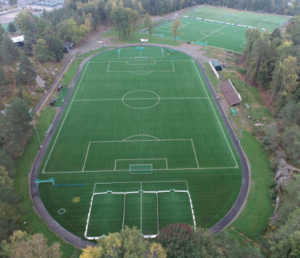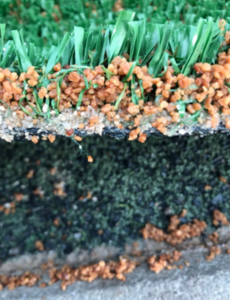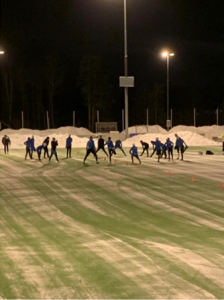When rubber crumb infill pollution was becoming a real problem in the local area of Faerder, the Norwegian football club, Teie IF, recycled one of their rubber crumb infill pitches to an artificial pitch with sand and olive stone infill as part of a wider refurbishment project. The pitch is not only microplastic-free, but is also thought to be one of the first 90% recycled pitch systems in the world. We ask Roger Nilson and Steinar Schjesvold, board member and leader of Teie IF, to tell us more:

Teie IF Refurbished pitch with olive stone and sand infill
Location: The Faerder municipality, Norway
Field type & use: The club has four 3G artificial football pitches, 3 x 11 player pitches and 1 x 7 player pitch. One of the 11 player pitches was converted from natural grass, and another was 90% recycled from SBR rubber crumb infill into an artificial pitches with sand and olive stone Infill. The remaining two pitches (1 x 11 player and 1 x 7 player) still use rubber crumb infill.
Infill type: Olive stone (2kg) and sand (11kg), and SBR rubber crumb.
Approximate cost of conversions: 100,000 Euros, Approx. 85,000 pounds
What were your reasons for using an organic infill?
Rubber crumb infill pollution in the immediate surroundings of the pitch was a real problem. The surrounding soil was visibly contaminated with rubber crumb and it was clear that a change was needed. The new alternative infill pitch was installed after a thorough clean-up of the area: 470 tonnes of contaminated soil were removed from under and around the old pitch. The club wanted a pitch which was environmentally friendly, could be played on all year round and would last a long time. They were also keen to recycle or reuse their existing pitches where possible.
How is the infill material produced?
The club used a Norwegian supplier for the sand and olive stone infill called Scanturf AS. The main pitches were installed with “Purefield Ultra HD” replacing the natural grass pitch and a “Purefield Classic HD” pitch was installed as the second recycled pitch. The old artificial pitch was sent to Re-Match A/S in Denmark, the field was recycled and returned as sub-components for the new pitch, almost 80% of old artificial turf was reused including 4,300m2 of the old shock pad. Even the rubber crumb was recycled, used to create the shock pad underneath the pitch.
How does the infill perform in terms of playability, safety and durability?
The pitch has performed well, especially in poor weather conditions and complies with the Nordic FA requirements for football pitch surfaces. The new pitch has good drainage: the infill material sinks with water into the pitch meaning water does not sit on the surface of the pitch, so play is possible in high rainfall.
The pitch has also performed well in snowy conditions, as the pad remains soft and durable. The club has been able to get more use out of the pitch in winter periods than their previous pitches (approximately 80 more matches and 130 more training sessions have been delivered on these pitches compared to the old ones in winter months).
There is also little infill appearing when the pitch is in use and currently there is predicted to be almost no escape of infill from the system. Therefore, infill material does not accumulate on the pitch surface in the same way as SBR granules, which can cause injury to players if they fall and scrape against the granule.
Are there any special considerations that need to be accounted for when using this infill?

Olive stone and sand infill shown on the top of the refurbished pitch
As with all systems the pitch has not been perfect from day one of installation. The infill lies quite high in the system for the first few weeks and, coinciding with a period of dry, hot weather, this caused some abrasions to the players and damaged shoes, and clothing. This meant there had to be increased maintenance and increased use needed on the pitch for the first couple of weeks. Moisture also had to be added and some refilling of the infill material itself was needed for this first period. However, after those first few weeks the pitch started to perform well.
The maintenance gear for the pitches also has to be adjusted to the height of the grass of these pitches, because the grass length is shorter than other artificial pitches.
As far as we know, no chemicals, such as herbicides or fungicides are needed to be used on this infill material to prevent unwanted conditions being created during production or use.
How can your pitch and infill be disposed of?
Because the infill is made from olive stones it is naturally biodegradable and there is no need for the material to be disposed in a special way. The shockpads on the new pitches are predicted to last 30-40 years.
What do the players think of the pitch?
Players have been pleased with the new pitches, they have been able to get more use out of the pitches in winter, and some players prefer the olive and sand pitches to the other rubber crumb ones.
The pitches with sand and olive stone are soft and comfortable to move on without being heavy. The Ultra HD pitch is softer then the Classic-HD pitch. Footballs “float” very well along the grass and there is good speed in the ball. The classic HD is faster for players than the Ultra HD pitch. The pitches appear even, well laid out and have an even distribution of infill. Players have reported their shoes get a good grip on the pitch.
Apart from the infill being high in the grass when first installed (which led to abrasions, wear and tear on the ball, equipment and clothing) which has gradually improved as use increased, the pitch has had little to no negative feedback.
What advice would you give to someone looking for an organic alternative to microplastic infill?

Players at Teie IF have been able to get more use out of the refurbished pitch in the winter seasons
Just go for it, so far our experience with the systems are very good.
Even through a winter with low temperatures, down to -20C, the courses have worked very well and it has been a good experience for our players. It is important to think holistically and that shock-absorbing pad, grass and infill are one system that must be put together correctly.
It has been a pleasure to collaborate with the various suppliers in the project. We have met a lot of skepticism and uncertainty from clubs and associations, but our choices have also created a lot of curiosity both regionally, nationally and internationally.
